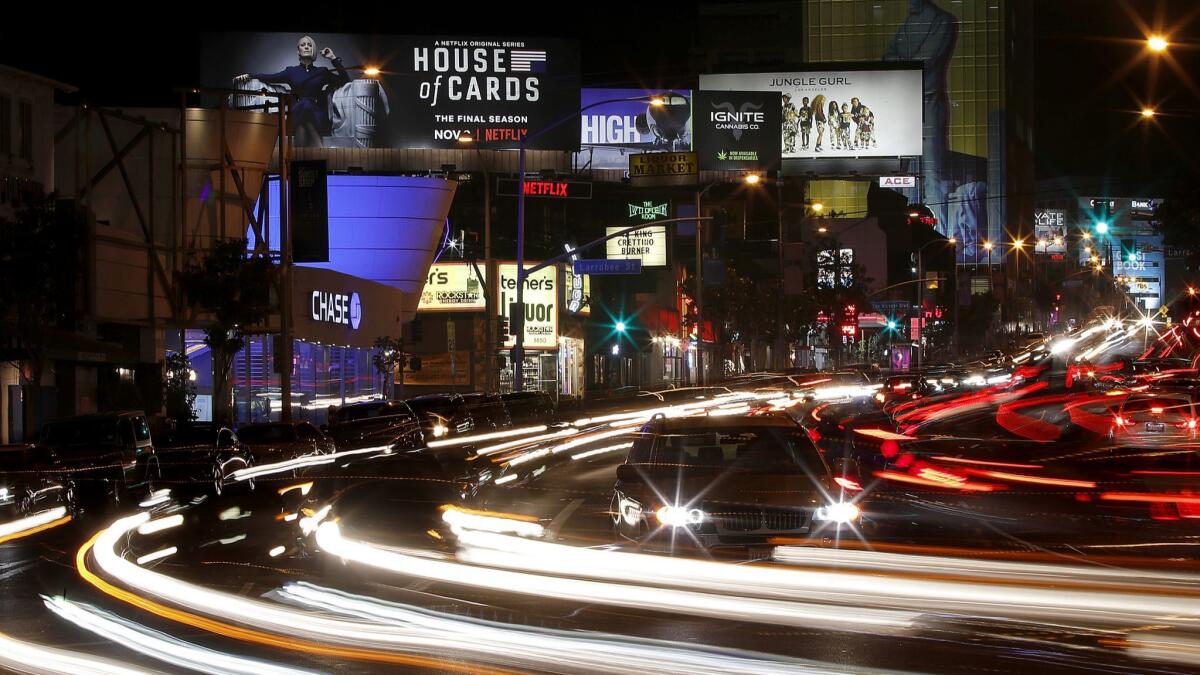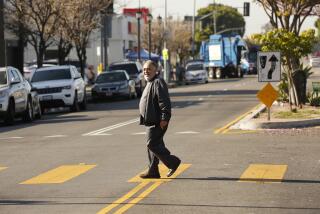Editorial: Speed kills. So do carbon emissions. So why does California give free rein to leadfoots?

Here’s another reminder that, despite the many pledges and programs to make it easier for people to bike, walk and otherwise get around without driving, California still treats the car as king.
This week the Los Angeles City Council reluctantly voted to raise the speed limits on more than 100 miles of streets. The council felt it had no choice because of a decades-old state law that essentially requires cities to set their streets’ speed limits based on how fast people are already driving there, regardless of whether that speed is safe.
The law was passed to prevent cities from setting speed traps, or arbitrarily low speed limits aimed at sticking drivers with pricey tickets. But it unwisely ties local officials’ hands and interferes with other priorities — namely, slowing traffic to make the streets safer for other users, including cyclists, transit riders, pedestrians and people with disabilities.
It’s a shame that Californians will have to wait at least a year for a more rational approach to setting speed limits.
The risks posed by higher speeds are well known. A pedestrian hit by a car traveling 20 mph has an 80% chance of survival, but someone hit by a car traveling 40 mph has just a 10% chance.
Nevertheless, under the state law, local police cannot use radar guns or other electronic devices to ticket speeding drivers — which is a key way to curtail dangerous driving — unless the city conducts regular surveys of traffic flow. The speed limit must then be set at the level 85% of the drivers complied with, rounded to the nearest 5 mph. If a traffic survey logs 100 trips down a street, the limit would be set just below the 15th fastest time recorded. As a consequence, cities often have to raise speed limits in order to enforce them with radar guns.
This is counterproductive and dangerous. It lets faster-than-average drivers dictate the speed limit, rather than basing the limit on what is best for all street users. It’s also contrary to California’s ambitious plans to slash greenhouse gas emissions. If the state is serious about getting people to drive less, the streets have to be safe for people to walk or bike.
Two months ago, Gov. Jerry Brown signed a bill by Assemblywoman Laura Friedman (D-Glendale) that creates a task force to review the speed limit law and recommend changes to better protect cyclists and pedestrians. Friedman’s original bill would have actually amended the law to give cities more authority to lower speeds on dangerous streets, but apparently that was too radical for the state’s stubbornly car-centric lawmakers.
Enter the Fray: First takes on the news of the minute from L.A. Times Opinion »
The task force will convene in July and will report to the Legislature by Jan. 1, 2020. It’s a shame that Californians will have to wait at least a year for a more rational approach to setting speed limits.
Of course, lower speed limits alone won’t make the streets safer. Cities — especially Los Angeles — need to engineer streets for safety. Often that means redesigning roads and intersections to make drivers slow down. It also means ensuring that communities have protected bike lanes, sidewalks and safe pedestrian crossings.
California leaders talk a good game about fighting climate change, reducing traffic fatalities and investing in transportation solutions, but they continue to leave outdated, car-centric laws on the books. It’s time for leaders to recognize that safe streets are truly a matter of life and death.
Follow the Opinion section on Twitter @latimesopinion and Facebook
More to Read
A cure for the common opinion
Get thought-provoking perspectives with our weekly newsletter.
You may occasionally receive promotional content from the Los Angeles Times.






